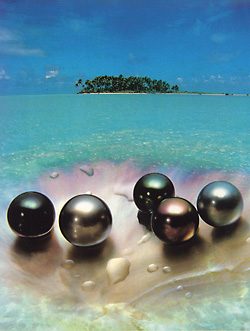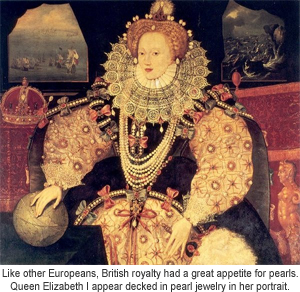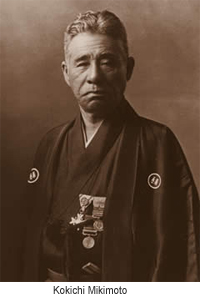The History of Pearls

The pearl’s allure has endured throughout history. Long
before the development of pearl culturing, molluscs were
producing natural pearls on their own. One of the most
extraordinary of them was the Hope Pearl. It’s the largest
know natural pearl, weighing 1800 grains (3oz). At its
widest point, its circumference is 4.5 inches. It resided in
a private collection in the 1800s, capped with a crown of
red enamelled gold set with diamonds, rubies, and emeralds.
It surfaced again in 1974, when it was offered for sale at
$200,000.
Most natural pearls are much smaller than the Hope. But this
doesn’t take away from the biological miracle of pearl
formation. Today, cultured pearls outshine their natural
counterparts in both availability and marketability. But it
was the mystique of natural pearls that inspired the
development of pearl culturing.
A thousand years before the birth of Christ, ancient
civilizations along the Nile fashioned iridescent
mother-of-pearl into simple ornaments. But ancient cultures
farther east discovered thee gem within the shell: the
product of the massive oyster beds that had been quietly
flourishing in the waters of the Persian Gulf, Red Sea, and
Indian Ocean for millions of years.
Cultures of the Middle East and Asia glorified the pearl
into a symbol of wealth, status, and virtue. From 599 to 300
BC, the powerful Persian Empire celebrated its wealth by
draping its rulers with pearl-studded robes and ornaments.
Their prominent display meant that Persia’s natural pearls,
and the value humans placed on them, could not stay hidden
from the outside world for long.
The people of ancient China, Japan, and the Pacific Islands
had been harvesting natural pearls of their own. China
fished its rivers and lakes, while Japan and the Pacific
Islands found pearls in the seas lapping their coast-lines.
When Alexander the Great’s east-west trade routes reached
the Orient, its people, already rich in native pearl
treasure, saw foreign pearls for the first time.
By 200 BC, east-west traders had established the great silk
roads to and from China. China satisfied the growing demand
for Chinese silk, jade, and other products, and used its
increased prosperity to buy Indian and Persian pearls. For
centuries, Chinese courts sagged under the weight of pearl
ornaments.
The Roman Empire
The Roman Empire of the first century BC was no stranger to
excess. As Rome’s power grew, so did its unquenchable thirst
for the pearls cherished by the Egyptian and Greek
civilizations they conquered.
When countries fell to Rome, their treasures also went to
the Romans. Roman lust for pearls was even a factor in
conquering other areas. Julius Caesar may have targeted
Britain for invasion because he suspected that region of
having natural pearl resources.
In the sixth century, the Byzantine cit of Constantinople
replaced Rome as a cultural capital. It also inherited the
Roman Empire’s wealth in the Persian Gulf. Byzantine
Christians adopted pearls as symbols of religious faith and
purity, and liberally decorated their churches’ religious
articles with the natural gem.
 European
royalty became as obsessed with the gem as their Perisian
and Roan counterparts had been centuries before. During the
Renaissance, which lasted from the 1300s to the 1600s,
European rulers acquired pearls hungrily, showing off their
lavish collections at public functions. Thee gowns and hair
of England’s Queen Elizabeth I were nearly obscured by
mounds of pearls to impress rivals and dazzle those of
lesser status. European
royalty became as obsessed with the gem as their Perisian
and Roan counterparts had been centuries before. During the
Renaissance, which lasted from the 1300s to the 1600s,
European rulers acquired pearls hungrily, showing off their
lavish collections at public functions. Thee gowns and hair
of England’s Queen Elizabeth I were nearly obscured by
mounds of pearls to impress rivals and dazzle those of
lesser status.
In the 1860s, excited Europeans learned of untouched pearl
sources in the warm southern waters off Australia. Employing
Australian aborigines as divers, the British profited from
the new supply of mother-of-pearl shell, which they used for
buttons and inlay work. The naturally occurring pearls were
a lucrative bonus.
Several discoveries of high quality natural pearls in North
American rivers set off local pearl rushes in New Jersey and
Ohio river towns. One of the most famous discoveries was a
large freshwater natural pearl discovered in 1857. The
treasure eventually found its way to the collection of
France’s Empress Eugenie.
Natural Pearls Today
Natural pearls today are no longer abundant in the world’s
oceans, lakes, and rivers. However, some natural pearls
centuries old have survived decay and still shine in museum
display cases or the jewelry collections of people who are
lucky enough to own them.
New natural pearls are rare. Fine quality natural pearls are
even more so. These treasures are in demand among antique
dealers who need natural pearls to replace deteriorated or
cracked pearls in estate jewelry items.
The Introduction of Cultured Pearls
Pearls symbolized perfection to people in ancient
civilizations partly because the gem emerged complete and
ready to use from the shell, needing no faceting or carving.
By the 1890s, however, as natural pearl resources all but
disappeared, experiments with culturing by human
intervention got underway in earnest.
 Three Japanese men responded to the public’s desire for
pearls in a time when that desire was becoming increasingly
difficult to satisfy. Tokichi Nishikawa, Tatsuhei Mise, and
Kokichi Mikimoto each contributed to the development of
modern pearl culturing techniques. Three Japanese men responded to the public’s desire for
pearls in a time when that desire was becoming increasingly
difficult to satisfy. Tokichi Nishikawa, Tatsuhei Mise, and
Kokichi Mikimoto each contributed to the development of
modern pearl culturing techniques.
Mikimoto
combined his culturing efforts with shrewd business sense,
and achieved international success. By the early 1920s, he
was marketing his cultured product worldwide. There was some
controversy, including a legal dispute, about the
authenticity of cultured pearls in relation to their natural
counterparts. But eventually the public accepted cultured
pearls. More people were able to afford lovely strands of a
gem that looked a lot like those worn by the royalty of days
past.
During the 1920s, pearls were especially popular among newly
rich Americans like the Morgans, Vanderbilts, and Carnegies,
who had made their fortunes during the industrial
revolution. The pearl, historically associated to boost
their social status. Great Britain’s Princess Alexandra,
daughter-in-law of Queen Victoria, was fond of pearls, and
her tastes influenced rich Americans anxious to imitate her. |